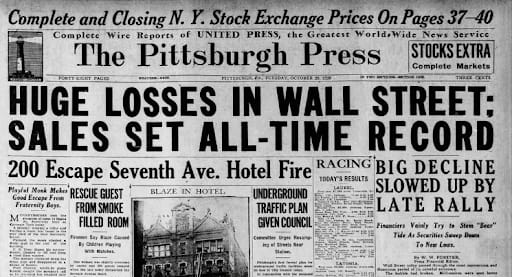- AI in Investment Research & Finance
- Posts
- Wall Street: Market Repricing & AI Analysis
Wall Street: Market Repricing & AI Analysis
+ Two Structured AI Prompts You Can Use Today
Welcome to AI in Investment Research and Finance
In this edition, we examine how artificial intelligence (AI) models may behave during market repricing as many asset prices, including technology shares and crypto, are currently under pressure. We also share a practical prompting approach that may help analyze and navigate for such volatility.
Table of Contents

This Week’s Focus: Repricing the AI Trade
Global equity markets have opened and also ended the week on softer footing as investors reassessed how much of the AI-driven rally is already embedded in stock valuations, especially in tech shares. Early in the week, a sharp shift in U.S. interest rate expectations set the tone: traders now see a relatively higher probability that the Federal Reserve (Fed) keeps policy unchanged, compared with near-certainty of a cut only a month ago. The repricing also weighed on European equities and contributed to more uneven leadership within U.S. tech, where the once-uniform AI momentum has begun to fragment.
Asia-Pacific markets were more mixed, while renewed geopolitical tensions, including Beijing’s latest travel advisory affecting Japan, added another layer of caution. Even AI darling Nvidia’s (NVDA) stronger-than-expected earnings, which briefly eased bubble concerns, did not fully offset unease around valuation sensitivity or the narrow concentration driving index-level returns.
Fund manager surveys reinforce this tension. Cash levels among investors have fallen to a “sell-signal” threshold. Yet 63% of global managers consider equities overvalued, and nearly half cite an AI bubble as the top tail risk. As a result, the central question is shifting from how fast AI demand can grow to how much of that growth is already priced in. And for analysts, this environment complicates real-time interpretation: filings, transcripts and market behavior move on different timelines.
This Week’s Partner: Masterworks
Crash Expert: “This Looks Like 1929” → 70,000 Hedging Here
Mark Spitznagel, who made $1B in a single day during the 2015 flash crash, warns markets are mimicking 1929. Yeah, just another oracle spouting gloom and doom, right?
Vanguard and Goldman Sachs forecast just 5% and 3% annual S&P returns respectively for the next decade (2024-2034).
Bonds? Not much better.
Enough warning signals—what’s something investors can actually do to diversify this week?
Almost no one knows this, but postwar and contemporary art appreciated 11.2% annually with near-zero correlation to equities from 1995–2024, according to Masterworks Data.
And sure… billionaires like Bezos and Gates can make headlines at auction, but what about the rest of us?
Masterworks makes it possible to invest in legendary artworks by Banksy, Basquiat, Picasso, and more – without spending millions.
23 exits. Net annualized returns like 17.6%, 17.8%, and 21.5%. $1.2 billion invested.
Shares in new offerings can sell quickly but…
*Past performance is not indicative of future returns. Important Reg A disclosures: masterworks.com/cd.
When AI Fills the Gaps
When market data and behavior no longer fully align, users of large language models (LLMs) may begin to note that LLMs could give answers that sound plausible but have no verifiable source. In other words, AI hallucinations are most likely to appear, often as confident claims about revenue trends that never happened or guidance drawn from the wrong period.
A quick illustration demonstrates the shift in the model’s behavior:
Standard prompt: “Analyze why [TICKER] declined 15% this month.”
Typical output: The model may produce a fluent narrative connecting recent earnings, specific margin trends and guidance adjustments; details that sound authoritative but may not appear in any filing.
Improved prompt:
“Using only the latest quarterly filing for [COMPANY] and verifiable market data for the month of [MONTH YEAR], explain factors that may have contributed to [TICKER]’s recent move. If information is missing, state that explicitly.”
Typical output: The model better describes valuation compression, sector rotation or rate sensitivity using confirmed figures, and notes where earnings data doesn't address the question.
The difference is simple: the second prompt forces the model to acknowledge the limits of the available data rather than filling gaps with statistically likely but unverifiable detail. To build prompts that consistently produce this kind of grounded output, three elements work especially well:
A precise timestamp: Direct the model to use data strictly from the latest quarterly or annual filing. This prevents blending across periods and keeps the analysis anchored.
Publicly verifiable information only: Restrict the model to filings, transcripts, official guidance, and observable market behavior. This narrows the scope to facts an analyst can check.
Clear refusal rules: Instruct the model to state explicitly when data is missing instead of generating an answer that approximates what “should” be there.
This approach can produce more concise or less fluid responses, and help avoid hallucinations. Such context and constraints within the prompt provide the structure required to keep outputs accurate, transparent and better aligned with correct information.
Also Sponsored By: Roku
CTV ads made easy: Black Friday edition
As with any digital ad campaign, the important thing is to reach streaming audiences who will convert. Roku’s self-service Ads Manager stands ready with powerful segmentation and targeting — plus creative upscaling tools that transform existing assets into CTV-ready video ads. Bonus: we’re gifting you $5K in ad credits when you spend your first $5K on Roku Ads Manager. Just sign up and use code GET5K. Terms apply.
Two AI Prompts for Volatility on Wall Street
Below are two prompts designed for this volatile investment environment. They combine clarity (role, task and sequence) with constraints (verified data only, refusal rules, references). This is the structure that keeps an LLM grounded when markets move fast and volatility increases.
📌 Prompt Example 1: Stock Analysis Anchored to Recent Conditions
Act as an equity analyst on Wall Street. Using only verifiable information from the [COMPANY’S] latest quarterly filing, earnings transcript or official guidance, analyze [TICKER] stock.
Specifically, provide:
1. Operating results: revenue, margins, EPS (state ‘No verified data available’ if missing).
2. Recent performance: describe how the stock has moved over the past month in [MONTH YEAR] relative to valuation changes, rate expectations and rotation within the [SECTOR].
3. Macro-sensitive risks: identify potential risks for [STOCK] if the Federal Reserve keeps policy restrictive, linking each risk to a specific financial metric.
4. Valuation view: assess whether the current [STOCK] price level is justified using only confirmed data.
Constraints:
• No estimates or invented numbers.
• No narrative filler.
• Cite the specific filings or transcript sections used.
This prompt forces the model to reference filings, interpret observable price behavior and avoid fabricated detail.
📌 Prompt Example 2: Compare Competitive Positioning
Act as a sector analyst on Wall Street. Compare [TICKER] with two of its main [INDUSTRY] peers using only the latest annual report and quarterly filings.
Include:
1. Relative fundamentals: growth, profitability, leverage, cash generation (use exact figures; state ‘No verified data available’ if missing).
2. Exposure to artificial intelligence (AI) volatility and repricing: verify revenue or capex links to AI and note how valuation multiples respond to shifts in the AI theme.
3. Key market metrics: evaluate cash-flow durability, earnings visibility and multiple-compression risk using verified data.
4. Summary view: classify [COMPANY] as stronger, in-line or weaker than peers based strictly on filings.
Constraints:
• No fabricated metrics.
• No thematic generalities.
• List the filings used for all companies.
Peer anchoring keeps the model focused on discrete, comparable numbers.
How We Can Support Your Business
We're a small team of investment professionals behind this newsletter focused on research, analysis and AI tools for finance. Drawing from decades of experience at funds, corporates and investment writing agencies in the U.S., U.K. and continental Europe, here's how we can support your business further:
AI Prompting Training for Investment Professionals: We offer live, in-person or online, global learning & development sessions on AI prompting for investment research, analysis and writing.
Investment Writing Services: Need high-quality content? We create fund commentary, investor letters, white papers and more, tailored to your voice and audience.
Feature Your Business: Showcase your company, products or services to our audience of investment professionals and retail investors.
LLM Training in the U.S., U.K. and Europe: Training the next-generation LLMs? We currently provide subject-matter consulting services to California-based LLMs (under NDA).
& Ways You Can Support Independent Research
Click Our Sponsor Links: Each click from our sponsors helps fund our research. (Yes, even one click matters.)
Share with your colleagues: If you like the content, please share it with your colleagues on social media platforms or at work.
Support Our Work: Value our insights? You can contribute and support us with a coffee here: https://ko-fi.com/investingprompts
For collaborations, training or writing services: [email protected]
Final Note
Structured prompts are one tool among many for working with AI models in finance and investment research. Their value increases when the gap between available data and analytical questions widens, which tends to happen during periods of rapid volatility and repricing.
Thank you for reading AI in Investment Research & Finance. Here’s to spotting tomorrow’s market stories today.
How did you like today's newsletter? |
Until next time!

